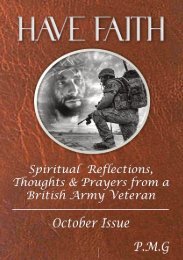The Sandbag Times Issue No: 49
The Veterans Magazine
The Veterans Magazine
You also want an ePaper? Increase the reach of your titles
YUMPU automatically turns print PDFs into web optimized ePapers that Google loves.
HISTORICAL TOMMY ATKINS<br />
Welsh Miners<br />
to the Rescue<br />
By Peter Macey<br />
<strong>The</strong> Manic Street Preachers in 1998 released<br />
their album ‘This Is Our Truth, Tell Me<br />
Yours’ which featured a track called, ‘If<br />
you tolerate this, then your children will be<br />
next’ . <strong>The</strong> song was inspired by the<br />
Spanish Civil War that took place between<br />
1936 and 1939 which involved volunteers<br />
from all over Europe but a large contingent<br />
from Wales.<br />
When unemployed Rhondda miner Harry<br />
Dobson was released from Swansea Prison<br />
in 1936 the first question he asked was,<br />
“How do I get to Spain?” Dobson had been<br />
serving a sentence for leading an anti-fascist<br />
disturbance in Tonypandy in June 1936.<br />
Around two hundred Welsh volunteers,<br />
mainly miners joined the left wing<br />
international brigade and fought for the<br />
Spanish Republic against General Franco’s<br />
fascist militia. Welsh miners were primarily<br />
Labour on communist at that time, largely<br />
from the central valleys. In truth the fight<br />
against fascism in Spain, between 1936 and<br />
1939, drew young men and women from all<br />
over Europe to form something of a rag-tag<br />
army in defence of the democratically<br />
elected Spanish Republican Government.<br />
Dobson was one of just over thirty Welsh<br />
men to be killed serving with the<br />
International Brigades which fought to save<br />
the doomed democratically elected Spanish<br />
Republic Government. This Welsh<br />
solidarity was referred to as taking the form<br />
of an anti-fascist barricade.<br />
One of the first siege’s in the war was at<br />
Gijón. <strong>The</strong> army in support of the<br />
Republicans attacked the small garrison<br />
between July and August 1936. <strong>The</strong>y laid<br />
siege to the Simancas barracks in the city of<br />
which was defended by nearly two hundred<br />
soldiers and Spanish Police who had signed<br />
up to support Franco’s movement. <strong>The</strong><br />
battle was remarkable for its viciousness<br />
and the stubbornness of the besieged.<br />
A Nationalist uprising of July 1936 fared<br />
poorly in Asturias due to the province being<br />
overwhelmingly hostile to Franco. <strong>The</strong> area<br />
was controlled by an effective council of<br />
state officials which including technicians<br />
and miners. <strong>The</strong> numbers involved and in<br />
support of the Republic were in the region<br />
of seventy thousand. <strong>The</strong> military governor<br />
of Gijón, Colonel Pinilla did not to declare<br />
loyalty to Franco but was in the Communist<br />
leader’s pocket. This was known to all and<br />
by late July the outpost was surrounded and<br />
cut off.<br />
<strong>The</strong> battle for Gijón was marked by Pinilla's<br />
resistance to give in knowing that the<br />
attackers had virtually no weapons to speak<br />
of other than dynamite. But until they<br />
secured Gijón's fall the Republicans could<br />
not concentrate their full numbers on their<br />
siege against the nationalists on Oviedo.<br />
<strong>The</strong> defenders soon ran out of water but still<br />
Pinilla refused to give in. He believed that<br />
relief was imminent. As the same time the<br />
siege of Alcázar in Toledo was taking place<br />
at which the Anarchists abducted Pinilla's<br />
son and threatened to slay him if the<br />
defenders refused to surrender. Pinilla<br />
ignored the threat and continued his defence<br />
of the city.<br />
By mid-August the miners had stormed the<br />
barracks, hurling dynamite as they charged.<br />
<strong>The</strong> barracks burned and the defence<br />
crumbled but rather than surrender, Pinilla<br />
sent a message to the Almirante Cervera,<br />
ordering it to open fire on his position. <strong>The</strong><br />
order was obeyed and the last defenders of<br />
Simancas barracks died in the flames.<br />
In October the following year Franco’s<br />
troops retook Gijón.<br />
Were any of your relatives involved in the<br />
Spanish Civil War? If so we would like to<br />
hear from you. Please contact us at SBT or<br />
Forgotten Veterans UK (FVUK) and tell us<br />
all about it.<br />
| 12 www.sandbagtimes.co.uk


















